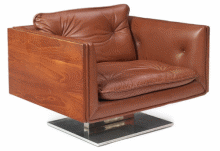The world of the architecture of the 1950s is rich and magnificent due to considerable “exploitation of new techniques and materials” (Woodham 1997, 11), and the designs by Franco Albini, Carlo Mollino, and Carlo Scarpa deserve much attention because these people worked during the same period and were mature enough to introduce different works.
Franco Albini was characterized as a “versatile artist” (Postiglione 2004, p. 22). His Margherita Chair (Image 1) is a unique work that demonstrates how his neo-rationalist ideas may be applied to the current style of life. He attempted to unite simple Italian lines with definite and obligatory grounds. In comparison to similar works offered by Warren Platner (Image 4) or Sally Hoban (Image 5) in the 1950s, where designers paid much attention to strength and fashion (use of leather and some powerful metallic constructions), Albini chose woven cane. He preferred to choose a thing that meant nothing and introduce something that could become the best of the best.
The achievements of Carlo Mollino should be also mentioned because he was one of the first designers who tried to introduce a new power of molding. His Arabesque Table (Image 2) is a tiny but still flexible construction from “bent plywood with glass top” (Hauffe 1998, p. 115). For the 1950s, such a choice of material was unpredictable because other representatives tried to use more reliable materials like wood and iron. The works of the 1950s by George Nelson (Image 6) and Paul McCobb (Image 7) show designers’ passion for strong material and strict forms. They did not want to experiment with forms and sizes as Mollino did. If they created tables, they should be of standard forms: round or square. Mollino proved that the more different forms were, the more attractive they could seem. On the one hand, it is an example of his flippancy. On the other hand, it is the best example of how novelties should be applied to the modern world.
Carlo Scarpa is another architect of the 1950s whose works and ideas impressed people for a long period. His buildings and attitudes to work differed considerably from those offered in the middle of the 1900s. Terry Kirk (2005) underlines that though Scarpa was not a certified architect, he made a successful attempt to create powerful works from new perspectives. His Ticket Booth (Image 3) is the work where Scarpa tried to unite the power of the stone and the fragility of glass. Other successful examples of novelty in design and architect were introduced by Le Corbusier (Image 8), and Antonio Graudi (Image 9). Their approaches to the creation of powerful and, at the same time, beautiful buildings find a number of supporters and admire.
It is useless to analyze what architect should begin the list of the best designers of the 20th century. The point is that there are many works which were offered to people by Albini, Scarpa, Mollino, etc., and it is time to remember about them and enjoy their beauty again.
Reference List
Hauffe, T 1998 Design. Laurence King Publishing, London.
Kirk, T 2005 The Architecture of Modern Italy. Princeton Architectural Press, New York.
Postiglione, G 2004 100: One Hundred Houses for One Hundred European Architects of the Twentieth Century. Taschen, Köln.
Woodham, JM 1997 Twentieth Century Design. Oxford University Press, New York.








